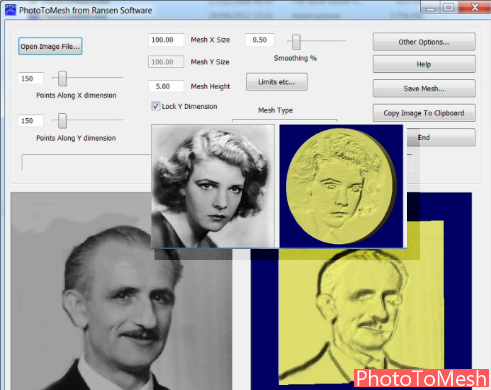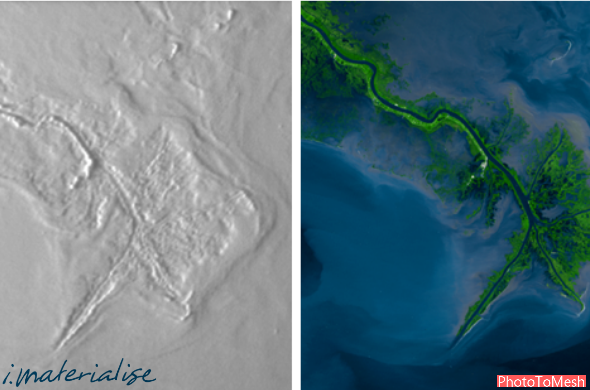Supporting the Mind’s Eye Through 3D Printed Tactile Learning Objects – For the Blind & Sighted Alike
 Among the many contributions that 3D printing has made to enriching people’s lives, the benefits to those with vision impairments or blindness are some of the most exciting. A new world of learning experiences is being presented to those with total or partial blindness through the creation of objects through which information can be felt. While many people are familiar with the idea of braille writing as a mechanism by which the blind can read through touch, many sighted people find themselves at a loss when contemplating other ways of perceiving visual information when seeing it is not an option.
Among the many contributions that 3D printing has made to enriching people’s lives, the benefits to those with vision impairments or blindness are some of the most exciting. A new world of learning experiences is being presented to those with total or partial blindness through the creation of objects through which information can be felt. While many people are familiar with the idea of braille writing as a mechanism by which the blind can read through touch, many sighted people find themselves at a loss when contemplating other ways of perceiving visual information when seeing it is not an option.
Rather than assuming that those with the gift of sight will simply enjoy greater access and richer experiences, many people are developing alternative ways of conveying visual information. Just as text to speech programs have exponentially increased access to written material by those with visual impairments, 3D printed objects can convey visual material through the sense of touch.
While it has long been possible to craft three-dimensional objects for use as educational tools, the cost of so doing has been sufficiently prohibitive, so that not until recently did they become part of the mainstream pedagogical imagination. With advances in 3-D technologies, such as that demonstrated in Owen Ransen’s PhotoToMesh software, the capture and reproduction of images made to be touched, has been both greatly simplified and made more widely accessible.
Dr. Kolitsky, a biology professor at Temple University in Philadelphia, has used Ransen’s software to create 3D bas-relief prints from 2D images. Kolitsky became interested in the possibilities for tactile learning products, created through 3D printing, when a friend of his who had been blind since birth asked him if he could provide 3D print files that he could use to test his new machine.
“He emailed me a few days later and says 3D printer works great but he thought that the rings of Saturn were circular, not elliptical. And then, in the next sentence, he said ‘ah, we’re viewing Saturn from the side so the circular rings appear elliptical. I was stunned. He learned about the rings of Saturn, but always envisioned the illustration of Saturn as having round rings, like the rings that go on your finger. Yes, Saturn does have round rings but only if they are viewed from the north or south poles. From the side, the rings appear elliptical. This was my first experience with how 3D printed tactile can enrich the learning experience for the blind or visually impaired.”
Dr. Kolitsky’s latest investigation into educational materials for the visually impaired is focused on the possibility for the creation of 3D prints from microscope slides. While there has been great interest in increasing the accessibility of courses with visual materials to students with visual impairments, the challenge requires a great deal more of intensive investigation.
 Students with visual impairments often shy away from classes and courses of study that were considered to be too heavily dependent upon visual material. Dr. Kolitsky, and many others hope that the integration of tactile learning objects will not only broaden access to the material for specific populations, but also reveal themselves to be a benefit to all students. After all, exploration through touch is a vital way to gain more information, and yet in most educational settings students are effectively touch blinded as teaching materials focus on visual and auditory aspects of learning. Imagine, if when learning about Bernini’s David, a student could run their hands along his furrowed brow. Whether as a blind student seeing this face for the first time through touch, or as a sighted student learning how to feel a surface, a richer experience is offered.
Students with visual impairments often shy away from classes and courses of study that were considered to be too heavily dependent upon visual material. Dr. Kolitsky, and many others hope that the integration of tactile learning objects will not only broaden access to the material for specific populations, but also reveal themselves to be a benefit to all students. After all, exploration through touch is a vital way to gain more information, and yet in most educational settings students are effectively touch blinded as teaching materials focus on visual and auditory aspects of learning. Imagine, if when learning about Bernini’s David, a student could run their hands along his furrowed brow. Whether as a blind student seeing this face for the first time through touch, or as a sighted student learning how to feel a surface, a richer experience is offered.
The greater the availability of knowledge in all of its varied forms, stronger it impacts. The democratization of 3D printing and its mainstream integration into education makes it an important tool for civil rights: accessibility to high-quality education by all students regardless of vision.
What do you think about this idea of creating tactile objects to aid in the education of the blind and sighted alike? Discuss in the 3D printed tactile objects forum thread on 3DPB.com.
[Source: i.materialise]Subscribe to Our Email Newsletter
Stay up-to-date on all the latest news from the 3D printing industry and receive information and offers from third party vendors.
Print Services
Upload your 3D Models and get them printed quickly and efficiently.
You May Also Like
Making Space: Stratasys Global Director of Aerospace & Defense Conrad Smith Discusses the Space Supply Chain Council
Of all the many verticals that have been significant additive manufacturing (AM) adopters, few have been more deeply influenced by the incorporation of AM into their workflows than the space...
EOS in India: AM’s Rising Star
EOS is doubling down on India. With a growing base of aerospace startups, new government policies, and a massive engineering workforce, India is quickly becoming one of the most important...
PostProcess CEO on Why the “Dirty Little Secret” of 3D Printing Can’t Be Ignored Anymore
If you’ve ever peeked behind the scenes of a 3D printing lab, you might have caught a glimpse of the post-processing room; maybe it’s messy, maybe hidden behind a mysterious...
Stratasys & Automation Intelligence Open North American Tooling Center in Flint
Stratasys has opened the North American Stratasys Tooling Center (NASTC) in Flint, Michigan, together with automation integrator and software firm Automation Intelligence. Stratasys wants the new center to help reduce...


































